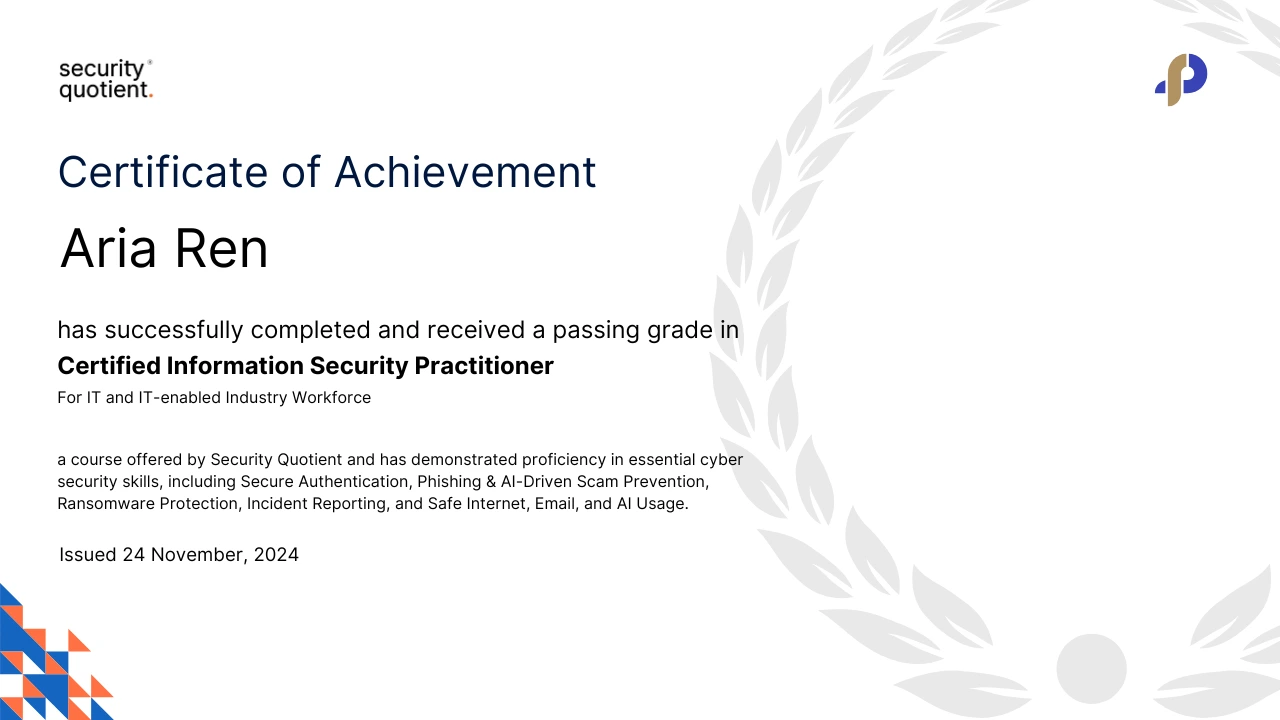Security Awareness Course
Certified Cyber Security Practitioner: Healthcare
For the Workforce in Healthcare Industry (with coverage of HIPAA)
A specialized cyber security awareness course designed for healthcare professionals, focusing on protecting patient data, preventing cyber threats, and ensuring compliance with healthcare regulations like HIPAA, GDPR, and other national data protection laws.
Why this Course?
The healthcare industry is a prime target for cyber threats, with attackers seeking to exploit sensitive patient data, disrupt healthcare services, and compromise medical devices. This course provides healthcare professionals with essential cyber security skills to recognize threats, follow best practices, and support compliance with HIPAA, GDPR, UK DPA, Singapore PDPA, Malaysia PDPA, and other healthcare data protection regulations.
Cyber Security in healthcare is not just an IT issue—it is a patient safety and compliance issue. Healthcare professionals handle sensitive Protected Health Information (PHI) and Personally Identifiable Information (PII) daily, making them key players in securing medical data and preventing breaches.
Learners will engage in scenario-based decision-making to develop real-world cyber security skills, ensuring they are prepared to prevent cyber incidents, protect patient confidentiality, and maintain regulatory compliance.
Designed for Healthcare Data Protection
Focuses on securing patient data, medical records, and digital health systems.
Real-World Cyber Threats in Healthcare
Prepares employees to tackle ransomware, phishing, and medical device vulnerabilities.
HIPAA & Global Compliance Readiness
Covers regulatory requirements like HIPAA, GDPR, and national data protection laws.
Incident Preparedness & Response
Equips learners with cyber security best practices to detect, report, and mitigate threats.
Target Audience
This course is designed for healthcare professionals at all levels who interact with patient data, medical records, and digital health systems. It is ideal for:
– Doctors, nurses, and clinical staff handling patient information and medical devices.
– Healthcare IT and security teams securing healthcare networks, EHRs, and connected systems.
– Hospital administrators and compliance officers ensuring adherence to HIPAA, GDPR, and national healthcare regulations.
– Medical researchers and healthcare service providers managing digital health data.
– Insurance providers and third-party vendors handling patient data within the healthcare ecosystem.
No prior cyber security knowledge is required—this course provides role-based training to help healthcare professionals secure patient data and ensure compliance.

Course Content
Through scenario-based learning, participants will develop real-world decision-making skills to proactively secure patient data, mitigate cyber risks, and support compliance with healthcare regulations.
Section 1. Understanding the Healthcare Cyber Threat Landscape
This module explores the growing cyber security risks in healthcare, including ransomware, phishing, and insider threats that target patient data and disrupt medical services. Learners will understand how cyberattacks impact patient care, hospital operations, and regulatory compliance. The module also highlights vulnerabilities in Electronic Health Records (EHRs), medical devices, and third-party systems, emphasizing the need for proactive security measures to protect healthcare infrastructure.
Section 2. Modern Cyber Attacks: Threats and Prevention
Cyber attacks are becoming more sophisticated, targeting organizations through advanced techniques and vulnerabilities. In this section, participants will explore common modern cyber threats—such as phishing, ransomware, and AI-driven scams—and learn effective prevention strategies. The focus is on recognizing attack patterns, understanding how they work, and applying best practices to defend against them.
Section 3. Key Standards and Frameworks for Healthcare Data Security
This module introduces HIPAA as the primary regulatory framework for protecting healthcare data and patient privacy, along with other global data protection laws such as GDPR, UK DPA, Singapore PDPA, Malaysia PDPA, India DPDP, and UAE PDPL. Learners will gain an understanding of compliance requirements, security best practices, and risk management strategies necessary for safeguarding Protected Health Information (PHI). The module emphasizes the importance of aligning security measures with regulatory standards to ensure legal compliance, data confidentiality, and operational integrity in healthcare organizations.
Section 4. Cyber Security Best Practices & Incident Preparedness in Healthcare
This module provides 10 critical cyber security best practices, tailored to the unique challenges of healthcare security and patient data protection. Each practice helps healthcare professionals minimize cyber risks, prevent data breaches, and maintain compliance with regulatory standards like HIPAA and GDPR.
4.1. Secure Authentication
Healthcare systems store sensitive patient data, making strong authentication essential. This best practice covers the importance of creating strong passwords, using multi-factor authentication (MFA), and implementing role-based access controls to prevent unauthorized access.
4.2. Identifying and Avoiding Phishing & AI-Driven Scams
Cybercriminals frequently target hospital staff with phishing emails and AI-generated scams designed to steal login credentials or install malware. This practice teaches employees how to recognize suspicious emails, verify senders, and report phishing attempts before they lead to data breaches.
4.3. Preventing and Responding to Ransomware Attacks
Ransomware attacks can shut down hospitals, encrypt patient records, and disrupt critical care services. This practice educates learners on how ransomware spreads, how to prevent infections, and the immediate steps to take if an attack occurs, ensuring patient data remains accessible and secure.
4.4. Identifying and Reporting Cyber Security Incidents
Early detection of cyber incidents can prevent major breaches. This practice covers the importance of monitoring for unusual activity, recognizing red flags, and following hospital incident response protocols to ensure swift action is taken when a security threat is detected.
4.5. Safe Internet and Email Practices
Unsafe browsing and email habits can expose healthcare organizations to malware, spyware, and data leaks. Employees will learn how to identify unsafe links, avoid downloading unverified attachments, and recognize security warnings to protect healthcare networks from cyber threats.
4.6. Preventing Data Mishandling & Unauthorized Access
Patient records must be handled with extreme care. This practice focuses on data access restrictions, secure file sharing, encryption methods, and preventing unauthorized disclosure to ensure that only authorized personnel can view or modify sensitive information.
4.7. Securing Your Mobile Devices
Mobile devices, including tablets, smartphones, and laptops, are widely used in healthcare but also introduce security risks. This practice emphasizes device encryption, secure app usage, remote wiping capabilities, and physical security measures to prevent patient data from being compromised.
4.8. Securing Remote Work Environments
The rise of telemedicine and remote healthcare services introduces new security challenges. This best practice teaches employees how to secure remote access connections, protect patient consultations, and follow HIPAA-compliant telemedicine security protocols.
4.9. Safe Social Media Use
Unintentional data leaks through social media posts, online messaging, and personal communications can lead to privacy violations and reputational damage. This practice helps employees understand what information should never be shared online, even in casual discussions, and how to follow organizational guidelines for professional conduct on social platforms.
4.10. Safe AI Usage Practices
AI is increasingly used in healthcare for diagnostic tools, predictive analytics, and automation, but improper usage can expose patient data or create security gaps. This practice guides healthcare professionals on using AI tools responsibly, securing AI-driven systems, and ensuring compliance with privacy regulations when integrating AI into medical workflows.
5. Summary and Results
In this final section, we reinforce the key cyber security principles essential for protecting patient data, medical systems, and healthcare operations. Participants will review critical best practices, reflect on their progress, and assess their ability to identify threats, prevent security incidents, and ensure compliance with healthcare regulations. The module also provides a summary of cumulative assessment results, helping learners gauge their readiness to apply cyber security measures in real-world healthcare environments.
Certification for Successful Learners
Recognize and reward employees who successfully complete the course with a company-branded certificate, reinforcing their commitment to cyber security.
Minimum Passing Score – 80%
Learners who score 80% or higher receive an official co-branded certificate#.
Digital & Shareable
Learners can showcase their achievement internally or on platforms like LinkedIn.
Drive Engagement
Providing certification motivates employees to adopt security best practices.
Company-Branded Certificate#
Each certificate is customized with your organization’s name.

Sample certificate with client logo co-branding
# Client logo co-branding is available only in Premium and Enterprise Plans.
Assessment Method
Instead of relying on a single final test, assessments are integrated throughout the course to measure understanding and promote continuous learning. Participants will apply their knowledge in scenario-based challenges, encouraging critical thinking and secure decision-making in business contexts.
Continuous Assessments
Integrated assessments at the end of each section.
Scenario-Based Decision-Making
Real-world simulations instead of multiple-choice questions.
Pass Score
A score of 80% or more is required to pass the course.
No Final Test
Learn progressively with assessments throughout the course.
Course Features
A time-sensitive and concise course designed for professionals. Accessible on any device, with integrated assessments for practical learning.
Interactive E-Learning
Scenario-based, interactive content for real-world application.
Learning Time – 45 Minutes
Quick, focused learning with minimal disruption to work.
Delivery via Secure LMS
Hosted on our LMS for seamless access and tracking.
Mobile Responsive
Fully accessible across all devices for flexible learning.
How to Get This Course?
All our courses are available as part of our subscription plans.
Equip your workforce with essential cyber security skills through our flexible subscription plans. Our plans include:
– Full Access to All Courses – Get unlimited access to our entire training library containing courses and micro-learning.
– Progress Tracking & Analytics – Monitor employee progress with detailed insights.
– Company-Branded Certification – Recognize and certify successful learners#.
– Advanced Behaviour Analytics – Delve deep into learning data to identify poor cyber security behaviours and its impact#.
– Expert Support – Dedicated assistance to help you implement training effectively.
# Available in advanced plans.

